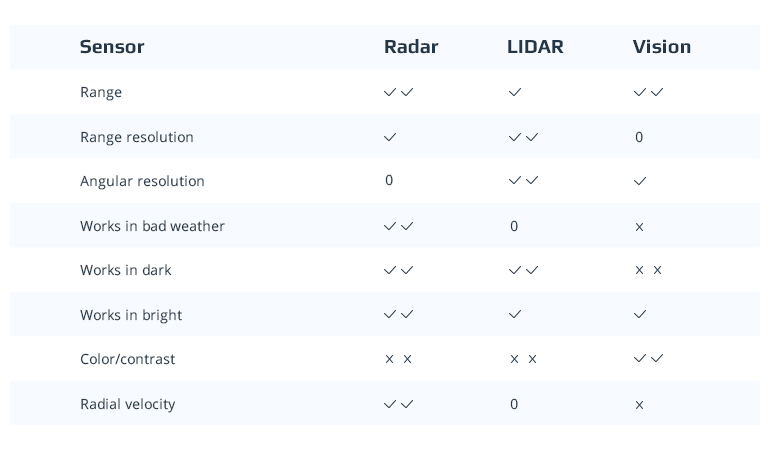🔦 LiDAR vs. Cameras

Source:: Velodyne
What’s LiDAR?
LiDAR stands for Light Detection And Ranging and is a remote sensing technology that uses laser pulses to scan the environment and determine distances from an object. With this information, LiDAR then replicates a 3D scanned copy of its environment. Its high accuracy allows it to detect objects such as rain, plastic, metal and even aerosols!
Just like how RADAR sends out electromagnetic waves and SONAR emits acoustic sound waves to determine distance, LiDAR emits light! The longer it takes the beam of light to bounce off an object and return to its source, the further away it is.
So why do some companies opt to use LiDAR while others prefer a RADAR/Camera combination?
Check out this article by Brad Templeton for an opinion on cameras vs. lasers! What are your thoughts?
Comparison is the Thief of Joy

Source: Medium
RADAR
- Emits radio waves
- Radio waves can travel farther than sound waves
- Can detect objects at a farther distance than LiDAR
- Can detect solids such as metal
- Detects an object’s position and speed at a distance
- Cannot produce an image due to a longer wavelength
- Inexpensive
- Less moving parts than LIDAR thus more reliable
SONAR
- Emits sound waves (like how a bat uses echolocation)
- Detects solids
- Good for detection in blind spots
LiDAR
- Emits laser light
- Can detect solids, aerosols, clouds
- Creates an accurate 3D scanned digital copy of an environment due to its short wavelength
- Excellent for mapping topography
- Less precise in night/cloudy conditions
- Expensive
- Light is faster than sound
- More moving parts than RADAR thus more room for error
Who’s Using What?
Tesla:
- “LiDAR is lame. It’s a crutch.” – Elon Musk
- While SpaceX developed and used LiDAR for docking Dragon with the Space Station, Tesla will not be using LiDAR in its autonomous vehicles
- 12 SONAR sensors around the vehicle for 360° coverage to help avoid obstacles
- Forward-facing camera to detect road signs and traffic lights
- RADAR in the front to detect up to 500 ft ahead of the car
Waymo:
- LiDAR mounted on the top for 360° scanning
- 9 cameras to detect road conditions in 360°
- RADAR in the back to detect objects in fog, rain, and snow
Uber’s Autonomous Volvos:
- LiDAR mounted on the roof
- Short and long range optical cameras around the vehicle
- RADAR mounted on the front with 360° view
Debate
There’s no need to select one over the other as all technologies complement each other nicely! However, it’s up to the manufacturers to determine which factors (such as cost, time to produce, and reliability) are most important.
